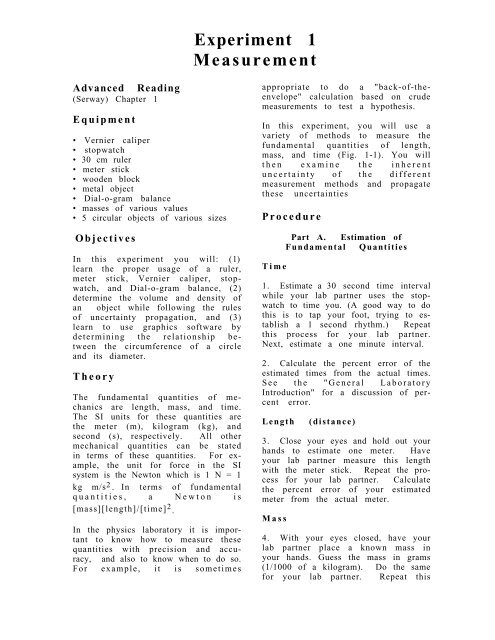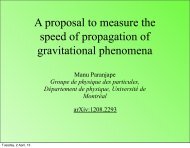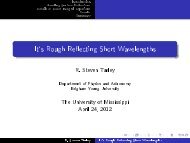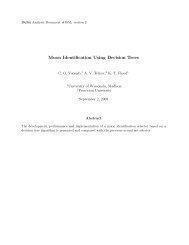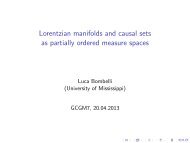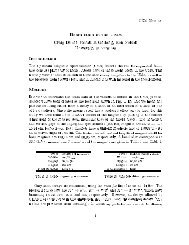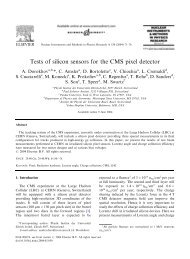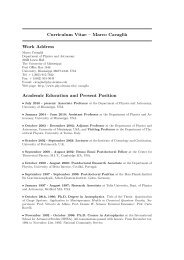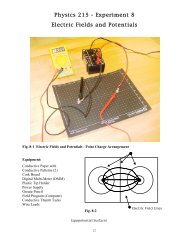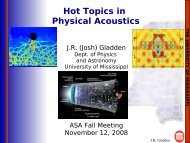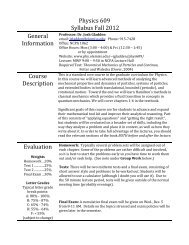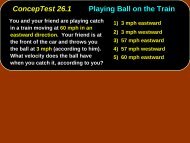Experiment 1 Measurement
Experiment 1 Measurement
Experiment 1 Measurement
Create successful ePaper yourself
Turn your PDF publications into a flip-book with our unique Google optimized e-Paper software.
<strong>Experiment</strong> 1<br />
<strong>Measurement</strong><br />
Advanced<br />
(Serway) Chapter 1<br />
Equipment<br />
Reading<br />
• Vernier caliper<br />
• stopwatch<br />
• 30 cm ruler<br />
• meter stick<br />
• wooden block<br />
• metal object<br />
• Dial-o-gram balance<br />
• masses of various values<br />
• 5 circular objects of various sizes<br />
Objectives<br />
In this experiment you will: (1)<br />
learn the proper usage of a ruler,<br />
meter stick, Vernier caliper, stopwatch,<br />
and Dial-o-gram balance, (2)<br />
determine the volume and density of<br />
an object while following the rules<br />
of uncertainty propagation, and (3)<br />
learn to use graphics software by<br />
determining the relationship between<br />
the circumference of a circle<br />
and its diameter.<br />
Theory<br />
The fundamental quantities of mechanics<br />
are length, mass, and time.<br />
The SI units for these quantities are<br />
the meter (m), kilogram (kg), and<br />
second (s), respectively. All other<br />
mechanical quantities can be stated<br />
in terms of these quantities. For example,<br />
the unit for force in the SI<br />
system is the Newton which is 1 N = 1<br />
kg m/s 2 . In terms of fundamental<br />
quantities, a Newton is<br />
[mass][length]/[time] 2 .<br />
In the physics laboratory it is important<br />
to know how to measure these<br />
quantities with precision and accuracy,<br />
and also to know when to do so.<br />
For example, it is sometimes<br />
appropriate to do a "back-of-theenvelope"<br />
calculation based on crude<br />
measurements to test a hypothesis.<br />
In this experiment, you will use a<br />
variety of methods to measure the<br />
fundamental quantities of length,<br />
mass, and time (Fig. 1-1). You will<br />
then examine the inherent<br />
uncertainty of the different<br />
measurement methods and propagate<br />
these uncertainties<br />
Procedure<br />
Time<br />
Part A. Estimation of<br />
Fundamental Quantities<br />
1. Estimate a 30 second time interval<br />
while your lab partner uses the stopwatch<br />
to time you. (A good way to do<br />
this is to tap your foot, trying to establish<br />
a 1 second rhythm.) Repeat<br />
this process for your lab partner.<br />
Next, estimate a one minute interval.<br />
2. Calculate the percent error of the<br />
estimated times from the actual times.<br />
See the "General Laboratory<br />
Introduction" for a discussion of percent<br />
error.<br />
Length<br />
(distance)<br />
3. Close your eyes and hold out your<br />
hands to estimate one meter. Have<br />
your lab partner measure this length<br />
with the meter stick. Repeat the process<br />
for your lab partner. Calculate<br />
the percent error of your estimated<br />
meter from the actual meter.<br />
Mass<br />
4. With your eyes closed, have your<br />
lab partner place a known mass in<br />
your hands. Guess the mass in grams<br />
(1/1000 of a kilogram). Do the same<br />
for your lab partner. Repeat this
process with several different<br />
masses. Calculate percent error.<br />
Part B. <strong>Measurement</strong> of fundamental<br />
quantities using more<br />
sophisticated techniques<br />
5. Using the 30 cm ruler, measure<br />
the length, width, and height of the<br />
wooden block. Estimate to a tenth of<br />
the smallest scale on the ruler. These<br />
measurements should be done by<br />
each lab partner. Calculate the<br />
block's volume using the average<br />
values of the length, width, and<br />
height. Your results should have the<br />
appropriate significant figures and<br />
include the propagated uncertainties.<br />
See section of text on significant<br />
figures.<br />
6. Each lab partner should measure<br />
the mass of the wooden block with<br />
the Dial-o-gram balance. (zero the<br />
balance before you start). Calculate<br />
the average mass. Calculate the<br />
density of the block using the<br />
volume from part 5.<br />
7. Using the Vernier calipers, measure<br />
all the dimensions needed to calculate<br />
the volume of the metal object.<br />
Each lab partner should make their<br />
own separate set of measurements.<br />
Calculate the volume of the object<br />
using the average values.<br />
8. Measure the mass of the metal<br />
object with the Dial-o-gram balance.<br />
Repeat three times and calculate the<br />
average. Use this value and the volume<br />
obtained in part 7 to calculate<br />
the object's density. Be sure to record<br />
this density in your notebook because<br />
it will be needed for one of the questions.<br />
Determination of π<br />
9. Using the Vernier caliper measure<br />
the diameter D, in centimeters,<br />
of each of the five circular objects.<br />
10. Using the ruler measure the<br />
circumference C, in centimeters, of<br />
each object. To do this, wrap a piece<br />
of string around each object and<br />
measure the length of string required<br />
to encircle the object.<br />
11. Graph C vs. D from parts 9 and 10.<br />
Use the graphics software on the<br />
computers. Use the linear fit<br />
command from the menu to plot a<br />
best-fit line. Label both axes properly,<br />
including the units. Refer to the<br />
"General Laboratory Introduction."<br />
Questions/Conclusions<br />
1. Why is it important for you to<br />
have a "feel" for mass, length and<br />
time (or more specifically, kilograms,<br />
meters, and seconds)?<br />
2. Based upon the density values<br />
found in a table of element properties,<br />
from what material is the metal<br />
object made? Calculate the percentage<br />
error of your density from the<br />
standard density. What could be responsible<br />
for the discrepancy?<br />
3. It is important to know how to<br />
convert various quantities in the<br />
metric system. In your lab report,<br />
make a table containing the masses of<br />
the metal object and the wooden<br />
block in both grams and kilograms.<br />
On the same chart, record the volume<br />
of the same objects in both cubic<br />
centimeters (cm 3 ) and cubic meters<br />
(m 3 ). Be sure to include the uncertainties<br />
of these values in the table .<br />
4. What is the value of the slope of<br />
the graph in step 11 of the<br />
procedure? What is the significance<br />
of this number? Recall that the<br />
equation of a line is given by y = mx +<br />
b, where is m the slope and b is the y<br />
intercept. Calculate the percentage<br />
error of your value from the true<br />
value. What could be responsible for<br />
the discrepancy?
<strong>Experiment</strong> 1<br />
<strong>Measurement</strong><br />
Figure 1-1<br />
Dial-o-gram balance, metal object, ruler, stopwatch and Vernier caliper.


